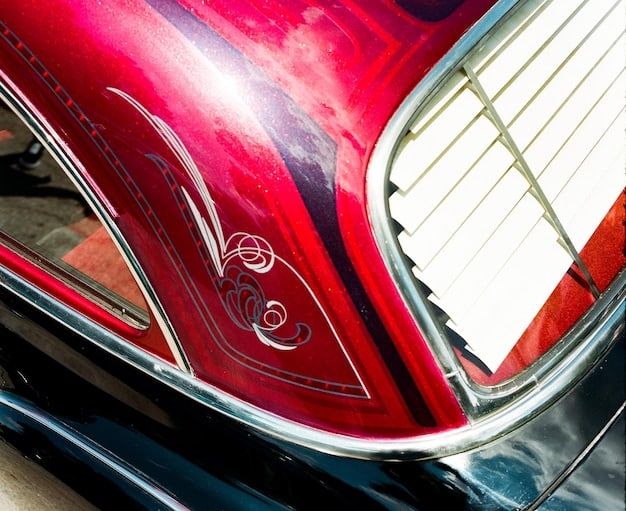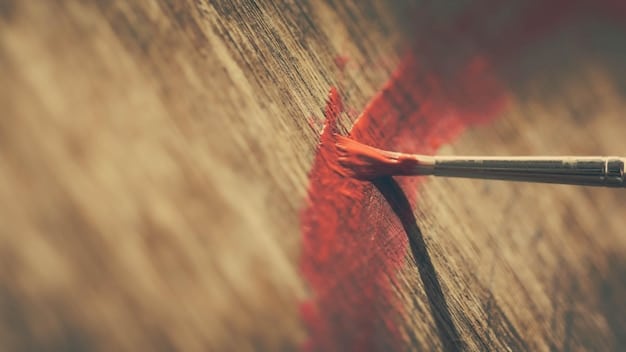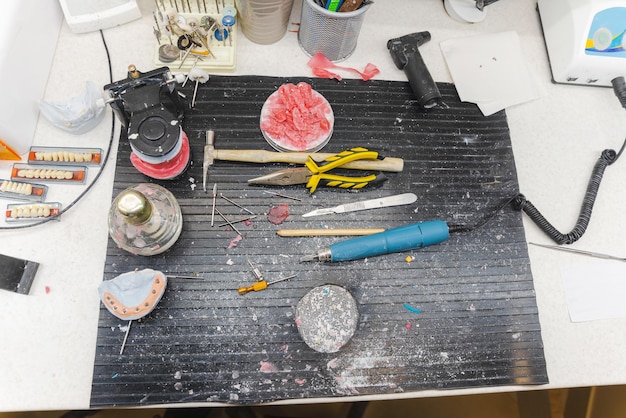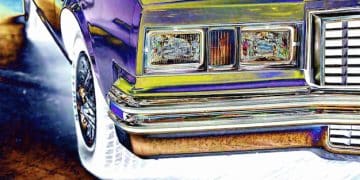Pinstriping: A Deep Dive into the History and Techniques

Pinstriping is a classic automotive art form involving the application of thin lines of paint to create decorative designs, enhancing the aesthetic appeal of vehicles with a touch of custom craftsmanship.
Discover the captivating world of the art of pinstriping: a deep dive into the techniques and history of custom car detailing, a timeless craft that adds a personalized touch to vehicles.
What is Pinstriping?
Pinstriping, at its core, is the application of very thin lines of paint or other materials to create a decorative effect. Traditionally, it’s seen on automobiles, but it extends to motorcycles, bicycles, and even furniture. Let’s delve into what makes this art form so special.
It’s a freehand art, meaning there are no stencils involved. Each stripe is painted by hand, making every design unique. This personal touch sets it apart from mass-produced decals and stickers.
The Allure of Hand-Painted Lines
Why do enthusiasts still choose pinstriping over modern alternatives? It boils down to character and authenticity.
- Unique Design: No two pinstripes are exactly alike, guaranteeing a one-of-a-kind look.
- Artistic Expression: Pinstriping offers artists a medium to showcase their creativity and skill.
- Timeless Appeal: It harkens back to an era when automobiles were not just machines but rolling works of art.
Whether it’s a subtle accent or an elaborate design, the artistry of pinstriping is unmistakable. It adds a layer of sophistication and individuality that other forms of customization simply can’t match.
In summary, pinstriping is more than just lines; it’s a testament to the enduring appeal of handcrafted art. It continues to hold a special place because of its ability to add unique and meaningful value to a vehicle’s appearance.
A Brief History of Pinstriping
The history of pinstriping is as rich and winding as the lines themselves. From its humble beginnings to its modern revival, pinstriping has evolved alongside the automotive industry. Let’s trace its fascinating journey through time.
Initially, pinstripes were used as a practical marking tool on horse-drawn carriages. They helped define sections and add a touch of elegance to the vehicles.
The Automotive Boom and Pinstriping’s Rise
With the advent of automobiles, pinstriping found new purpose and popularity.
Early automobiles were often painted in solid colors, but pinstripes offered a way to break up the monotony and add visual interest. Skilled craftsmen applied these lines to enhance the car’s features. By the 1950s, pinstriping was ubiquitous in car culture.
As auto manufacturing processes became more streamlined, the demand for hand-applied pinstripes diminished. Mass-produced decals and vinyl graphics offered a quicker, cheaper alternative. However, pinstriping never completely disappeared.

In recent years, there’s been a resurgence of interest in traditional crafts, including pinstriping. Custom car builders and enthusiasts have rediscovered the beauty and authenticity of hand-painted designs. This revival has kept the art form alive and spurred innovation. With renewed appreciation, pinstriping stands as a symbol of individuality and craftsmanship.
Essential Tools and Materials
Pinstriping requires a unique set of tools and materials. The quality of these items directly impacts the final result. Understanding what you need is crucial for both beginners and seasoned artists. Here’s a look at some essentials.
The most iconic tool is the pinstriping brush. These brushes are specially designed with long, fine bristles that hold plenty of paint and allow for smooth, consistent lines.
Paint Types and Their Uses
Choosing the right paint is just as important as the brush. Here are some popular options:
- Enamel Paints: Durable and glossy, ideal for outdoor applications.
- Acrylic Lacquers: Quick-drying and easy to work with, but may require a clear coat for protection.
- One-Shot Paints: Highly pigmented and self-leveling, preferred by many professionals.
Besides brushes and paints, you’ll need a variety of other materials to prepare the surface and protect your work. This frequently includes:
Cleaning solutions, masking tape, and clear coat top things off. Mastering these tools ultimately allows artists to create stunning designs with precision and flair.
Basic Pinstriping Techniques
Pinstriping involves skills that require careful practice. While it looks easy, mastering the techniques takes time and dedication. Let’s review the basic strokes and patterns that form the foundation of pinstriping.
The most fundamental technique is drawing a straight line. This involves holding the brush at the correct angle and maintaining a steady hand.
Mastering Curves and Swirls
Curves and swirls add complexity and elegance to pinstriping designs.
- Practice Arcs: Start with simple arcs and gradually increase the complexity.
- Use Your Whole Arm: Avoid just using your wrist; move your entire arm for smoother curves.
- Maintain Consistent Pressure: Keep the pressure even to ensure uniform line width.
Symmetry is key to many pinstriping designs. Achieving perfect mirror images takes careful planning and execution. Laying out a symmetrical design requires thought as to where the eye is naturally drawn. It’s these core techniques that enable artists to bring their imaginative ideas to life.

Advanced Pinstriping Designs
Once you’ve mastered the basics, you can explore more complex designs. These take practice and finesse. Here are some advanced techniques that can elevate your pinstriping work.
Layering involves painting multiple lines of different colors to create depth and dimension. This technique can add a three-dimensional effect to your designs.
Shading and Highlighting Techniques
Adding shadows and highlights can make your pinstripes pop.
Shading involves applying darker tones to one side of a line to create the illusion of depth. Highlighting uses lighter tones to emphasize certain areas and catch the eye. Combining these effects makes your designs look more dynamic.
Integrating lettering and graphics into your pinstripes can add a personal touch. Consider the following techniques for graphics and lettering projects:
- Sketch First: Always sketch your design before painting.
- Use Templates: Templates can help you achieve clean, precise lettering.
- Practice Regularly: The more you practice, the better you’ll become at incorporating these elements.
These advanced techniques can transform simple pinstripes into stunning works of art. Each method offers its own set of challenges and rewards, ensuring consistent improvement.
Caring for Your Pinstriping
Once you’ve invested time and effort into pinstriping your vehicle, proper maintenance is essential. Well-maintained pinstripes can last for years, keeping your vehicle looking its best. Let’s explore some tips for keeping your lines pristine.
Regular cleaning is the first step. Use a mild soap and water solution to gently wash the pinstriped area.
Protecting Against the Elements
Harsh weather can damage pinstripes. Here are some protective measures:
- Wax Regularly: Apply a coat of wax to protect the paint from UV rays and contaminants.
- Avoid Abrasive Cleaners: These can scratch and dull the finish.
- Park in the Shade: Prolonged exposure to sunlight can fade the colors.
If your pinstripes get damaged, it’s important to address the issue promptly. Small chips and scratches can be repaired with touch-up paint. More extensive damage may require professional restoration. With diligence and care, your pinstriping will continue to enhance your vehicle’s aesthetic.
| Key Point | Brief Description |
|---|---|
| 🎨 Definition of Pinstriping | Hand-applied thin lines adding unique custom detail. |
| 🗓️ History | Evolved from carriages to automotive art, now seeing a revival. |
| 🛠️ Tools & Materials | Special brushes, quality paints, cleaning and protection gear. |
| 🛡️ Maintenance | Regular cleaning and protection from elements ensure longevity. |
Frequently Asked Questions About Pinstriping
▼
Pinstriping is hand-painted, offering unique designs, while vinyl graphics are mass-produced decals. Pinstriping boasts authenticity and artistic flair that vinyl can’t replicate.
▼
With proper care, pinstriping can last several years. Regular cleaning and waxing protect it from the elements, ensuring the design remains vibrant and intact.
▼
Yes, with dedication and practice, you can learn pinstriping. Start with basic techniques and gradually advance to more complex designs for steady improvement.
▼
One-Shot paints are often favored by professionals due to their high pigmentation and self-leveling properties. Enamel and acrylic lacquers are also viable options.
▼
Clean pinstriped surfaces with mild soap and water. Avoid abrasive cleaners or harsh chemicals that can damage the paint and dull the finish of the stripes.
Conclusion
The art of pinstriping remains a vibrant and cherished tradition in the automotive and custom culture. Whether you’re an enthusiast, a collector, or simply someone who appreciates fine craftsmanship, understanding the techniques, history, and care involved in pinstriping offers a deeper appreciation for the artistry and skill that goes into each hand-painted line.





